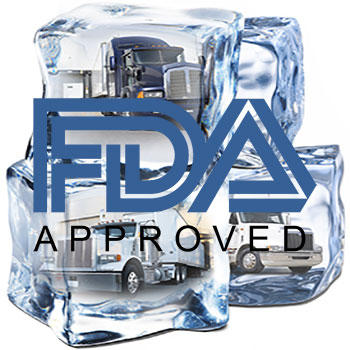For Freight Forwarders New Regulations Complicate The “Cold Chain”

Forwarders who specialize in the controlled temperature marketplace are facing more regulations now than ever, but by bringing new technology into the fore, they can quickly meet compliance standards and differentiate their service.
Here’s some advice for shippers looking to solve the “cold chain” challenge with the help of a third party.
While shippers typically rely on forwarders to help them with quality specifications and export documentation, the challenge is far more daunting when it comes to the movement of perishable goods.
Food, beverage, bio-med, and pharmaceuticals are among the most vulnerable to supply chain risk; however, a capable middleman will not only mitigate risk, but prevail over the various challenges of the “cold chain.”
“The fastest growing sector for U.S. exporters are food and agricultural goods,” says Donna Mullins, president of Mullins International Solutions, a compliance, training, and consulting firm for international trade. “Our job as forwarders is to help these shippers enter new markets without getting into trouble and to navigate the regulatory network - and that takes constant diligence and education.”
Geoffrey Powell, president of the National Customs Brokers & Forwarders Association (NCBFAA) couldn’t agree more. “When the NCBFAA met last month, cold chain issues were high on the agenda,” he says. “We all fully understand that there’s an evolving, and very complex checklist for forwarders and their shippers to complete in 2015.”
For example, in packing items for export, both parties should be aware of the demands being put on the shipment, like breakage, weight, moisture, and pilferage. “Moisture is a constant problem because cargo is subject to condensation even in the hold of a ship equipped with air conditioning and a dehumidifier,” adds Powell. “The cargo could also be unloaded in the rain and some foreign ports do not have covered storage facilities.”
But that’s just scratching the surface of the new challenges on the rise for cold chain shippers.
Analysts suggest that shippers should turn to the Transportation Intermediaries Association (TIA) and International Federation of Freight Forwarder Associations (FIATA) as valuable resources for guidance in this arena as well.
In fact, leaders with all three groups are comparing notes and sharing a number of independent advice bulletins. Here are two suggestions that the groups deem as most important.
1) Document Everything
Analysts stress that while forwarders must know logistics requirements for temperature, sanitization, and traceability of food at all stages of the cold chain, the most important bit of information regards the U.S. Food and Drug Administration’s (FDA) Food Safety Modernization Act (FSMA).
Signed into law by President Obama in 2011, the FSMA enables the FDA to better protect public health by strengthening the food safety system. According to the FDA, the law enables the organization to focus more on preventing food safety problems rather than relying primarily on reacting to problems after they occur.
However, the new rules present a new set of challenges for shippers that deal with food and produce, and have put additional pressures on companies that must now comply with an entirely new set of regulations. DHL and other major forwarders are launching new technology platforms to simplify FSMA this year.
“The main problem is that many cold chain corporate supply chain organizations are siloed, operate on a regional basis, and are disconnected among regions and even sites,” says Tobias Larsson, head of DHL’s Resilience Team, a unit specialized in end-to-end supply chain risk management. “And as a result, they lack visibility and span of control beyond their part of the operation,” adds Larsson. “That may work day to day, but when you’re in crisis and looking to fully comply with FSMA, it can be a problem.”
UPS is another mega forwarder providing tailored services in the cold chain, especially for pharmaceutical shippers. It’s Temperature True division is led by Susan Li, who says that trends such as industry collaboration and convergence mean that supply chains must become more inter-connected if they’re going to succeed today.
“When it comes to FSMA compliance, the old linear model is out, and flexible logistics networks are in,” says Li. “Companies who are market leaders in efficiency are becoming more innovative in how they leverage partnerships and new distribution models to enter new and emerging markets and serve new customer bases. They’re taking advantage of existing third-party assets, such as multi-client distribution centers and external regulatory expertise.”
Furthermore, says Li, there are mounting business and financial risks if your supply chain operations don’t become agile. “Companies that build true logistics networks will gain the agility and efficiency to adjust their supply chain strategy with their evolving business needs and goals,” she says. “This will open the door to new innovations and global opportunities,” she adds.
Under the FSMA, the FDA requires manufacturers to ensure product integrity throughout its distribution, which includes storage and warehousing, regardless of where that occurs. In addition, regulatory requirements include control and validation of logistics services.
According to Li, it’s therefore important that manufacturers review the procedures and facilities of logistics providers to ensure that all guidelines are being followed with the same exactitude the FDA would expect of the manufacturers themselves.
There are other regulatory bodies, trade associations, and standards-setting organizations that have developed rules or guidance for the cold chain. These rules do not have the force of law that an FDA inspection would have, but they can become part of the commercial agreement between a shipper and a forwarder. They also represent a defined way of specifying a service level for a dedicated cold chain service.
2) Trust But Verify
Given that there are hundreds of pages of rules, procedures, and evaluations to perform as specified by these documents, shippers must obviously choose a forwarder with extreme care.
However, in a functional sense, it all boils down to making certain that the forwarder can ensure that a shipment stays within a specified temperature range throughout its transportation and storage - and that the forwarder documents the steps that were followed in that process.
There are two ways to provide that assurance, state FDA guidelines. First, have forwarders put reliable temperature sensors on the package and record the package’s temperature across the cold chain. Secondly, have the forwarder test and validate the shipping container or package that the product is conveyed in.
According to analysts, shippers should, at the very least, expect forwarders to test and validate all the vehicles used in the supply chain. “The loading and unloading procedures are crucial,” says Jennifer Wade, president at Embrava Group, a management consulting and strategic project management company, “Then they should test and validate the shipping lane, test and validate the storage facilities that will hold the package, and provide suitable documentation that all these steps are within a defined range of operation that meets both regulatory requirements and manufacturers’ specifications.”
The International Association of Refrigerated Warehouses (IARW), part of the Global Cold Chain Alliance, notes that a number of cold chain forwarders are voluntarily opting to participate in third-party certified audits, despite high costs and increased personnel responsibilities.
Anthony Leo, CEO and President of the warehousing group at RLS Logistics, adds “that by voluntarily subjecting their companies to third-party audits, forwarders are taking professional, proactive, and differentiating positions in a highly competitive marketplace.” But risk mitigation experts feel that there’s more to be done to limit exposure in this highly volatile arena.
“Even though shippers may be assured that the forwarder is conducting all these tests in good faith, cold chain shippers should carry enough insurance to cover a worst case scenario,” says Linda Conrad, head of strategic business risk at Zurich Insurance.
Forwarders should be asked to provide “door-to-door” coverage, says Conrad, and as customized as possible. For example, if cargo is moving by ocean vessel, the forwarder should ask for “bottom stowage,” as this can further protect goods from being damaged in a storm.
“A good forwarder can also lessen the chances of theft if the contents of the shipment are not openly displayed,” says Conrad. In addition, strapping, seals, and shrink-wrap are effective means of deterring stealing. “The most important thing a forwarder can do for you in the cold chain is to ensure that the multiple tiers of partners are protected in some way,” she adds. “The shipper is not the only one risking the loss of a specific movement of goods, after all.”
What really matters in the long-term, experts agree, is brand integrity and reputation. Both the shipper and forwarder should be teaming to make the process more resilient in the face of an unprecedented business interruption. “The cold facts of the matter make this a high-stakes game from start to finish,” adds Conrad.
Mobile Execution: An Imperative in Cold Chain Integrity

Inside a refrigerated warehouse, a life sciences product awaits distribution to a customer.
Once it becomes part of an order, the product is moved from its climate-controlled environment to a cold shipping package, then driven (or, more likely, air-lifted) to its final destination.
The pervasive challenges throughout that entire process? Keeping the product in a specified temperature range, no matter the circumstances - and documenting the proof of temperature in a format that can be accessed anytime, anywhere to address consumer concerns and regulatory compliance.
These two capabilities are critical to cold chain execution - and for companies in the life sciences and food industries, they’re no strangers to constantly juggling these demands.
Yet as supply chains become increasingly complex and product demand grows, it’s more difficult to keep the cold chain intact in a way that maximizes efficiency while protecting product quality and integrity.
The solution? A mobile supply chain.
What a Mobile Supply Chain Can Do for Cold Chains
With a mobile supply chain in place, cold chain companies have visibility into the complete movement and lifecycle of products.
This traceability is key not only to maintaining product integrity, but also consumer confidence - and is enabled by mobile execution at any point of activity in the supply chain.
That key capability - mobile execution - is one that’s crucial to keeping the cold chain intact. A mobile supply chain combines information gathered from environmental sensors, time on conveyors, estimated shipping time and product attributes, among other sources, to ensure documented quality of delivery.
Because a mobile supply chain functions in real time, you can also enable the monitoring capabilities that provide another key layer of quality control. Say, for example, a product is removed from a refrigerated environment but isn’t promptly placed into the cold shipping package.
A mobile supply chain notifies you so that you can immediately address a problem and take corrective action before it results in permanent damage to the product - or, in a worst-case scenario, harm to a consumer.
There’s no denying that the stakes are always high in the cold chain. But with a mobile supply chain, you’ll have the technology framework and mobile-optimized workflow to not only meet critical cold chain demands, but also ensure your cold chain execution is as efficient and effective as possible.
Download the White Paper: Why End-to-End Supply Chain Visibility Depends on Mobile Execution
Article Topics
DSI News & Resources
For Freight Forwarders New Regulations Complicate The “Cold Chain” Leveraging a Mobile Platform for Automated Data Collection and Beyond Is Your Supply Chain Ready to Do Digital Business? Why End-to-End Supply Chain Visibility Depends on Mobile ExecutionLatest in Transportation
The Two Most Important Factors in Last-Mile Delivery Most Companies Unprepared For Supply Chain Emergency Baltimore Bridge Collapse: Impact on Freight Navigating Amazon Logistics’ Growth Shakes Up Shipping Industry in 2023 Nissan Channels Tesla With Its Latest Manufacturing Process Why are Diesel Prices Climbing Back Over $4 a Gallon? Luxury Car Brands in Limbo After Chinese Company Violates Labor Laws More TransportationAbout the Author

















